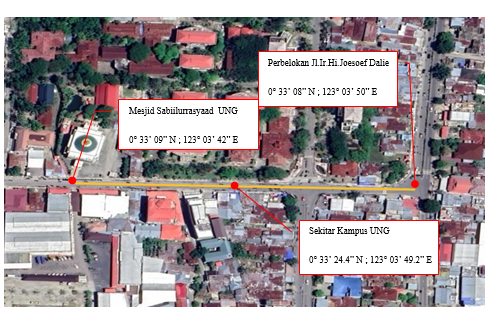Nitrogen dioxide (NO2) levels and health problems in street sellers around Universitas Negeri Gorontalo (UNG)
DOI:
https://doi.org/10.31943/gw.v14i3.550Keywords:
Nitrogen dioxide (NO2), health problems, GorontaloAbstract
Air is the most critical factor for human survival, which must and must always be maintained for quality. If the air quality changes from normal, the air has been polluted. Transportation activities are one of the contributing factors to air pollution. UNG is one of the largest campuses in Gorontalo Province, which involves students in increasing the number of residents outside the area who have an impact on campus activities and an increase in the number of vehicles. In the UNG area, street vendors sell from 6 in the morning to midnight. This makes street vendors a group at risk of experiencing health problems due to exposure to NO2 from vehicle exhaust emissions. This type of research is observational with a descriptive study design. This research was conducted on Jalan Jendral Sudirman, around the UNG campus. The population in this study were all street vendors selling around the UNG campus, totaling 58 traders. The sampling technique uses the Total Sampling technique; the entire population is used as a sample. The results showed that the average concentration of NO2 around the UNG campus did not exceed the quality standards set by Government Regulation No. 22 of 2021, namely 0.2 mg/m3, and the most common health complaints experienced by respondents were coughing 43 people (74.1%), body aches and headaches 36 people (62.1%), runny nose 32 people (55.2%), sore throat 12 people (20.7%). Moreover, the least experienced was eye irritation in 2 people (3.4%). It is suggested that there should be monitoring of pollutant concentrations, and it is hoped that street vendors will use masks when selling and reduce selling time.
Downloads

Downloads
Published
How to Cite
Issue
Section
License
Copyright (c) 2023 Ayu Rofia Nurfadillah, Ariani Hutuba, Siti Melisawati Djafar

This work is licensed under a Creative Commons Attribution 4.0 International License.
The use of non-commercial articles will be governed by the Creative Commons Attribution license as currently approved at http://creativecommons.org/licenses/by/4.0/. This license allows users to (1) Share (copy and redistribute the material in any medium) or format; (2) Adapt (remix, transform, and build upon the material), for any purpose, even commercially.









